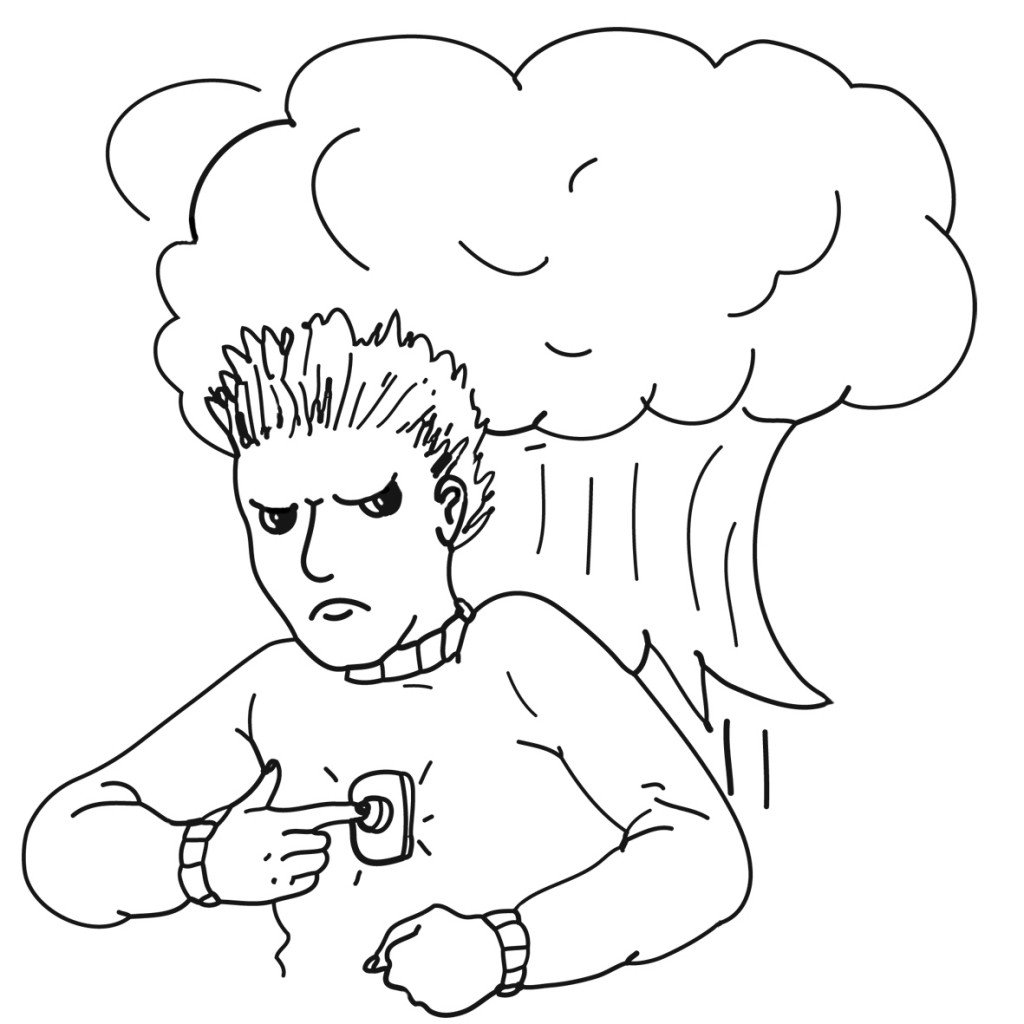Emotional stew, anyone? When we think of our skeletons, we often experience an overwhelming emotional mix. We have addressed some of these feelings already, such as shame and fear. One we haven’t talked about much yet is anger. Do you ever feel like you’re smouldering? Or like a ticking bomb? You may feel like it possesses you, making you into a different person. You may be angry:
- about what happened to you.
- at yourself.
- because life is different now (anger/resentment).
- because you are extremely frustrated about your current circumstances.
- because you don’t know how else to deal with the pain.
Just like any other emotion, anger can be overcome, decreased and brought back into balance using intentional thinking and staying in the present. But if you are hypoglycemic, the mood swings you experience may be contributing greatly to your anger (see Appendix 2), so I encourage everyone to explore this medical cause as well as the ideas presented here.
 Do you have buttons? You know, if someone pushes your buttons, you lash out so quickly and strongly, there seems to be no way you can stop it? You feel suddenly and intensely defensive. The button ― the comment or action that triggers your anger ― is often powered by a repressed or denied memory from painful childhood events. When a child experiences rejection, often in the form of a parent’s anger, contempt or unkindness, he/she can take that to heart in a way that is normal for a child but disproportionate for an adult. So now, when something triggers a similar feeling of rejection, you may react disproportionately ― with fierce anger. This anger, like any other emotion, can be repressed for a time but will come exploding out when the pressure gets too great.
Do you have buttons? You know, if someone pushes your buttons, you lash out so quickly and strongly, there seems to be no way you can stop it? You feel suddenly and intensely defensive. The button ― the comment or action that triggers your anger ― is often powered by a repressed or denied memory from painful childhood events. When a child experiences rejection, often in the form of a parent’s anger, contempt or unkindness, he/she can take that to heart in a way that is normal for a child but disproportionate for an adult. So now, when something triggers a similar feeling of rejection, you may react disproportionately ― with fierce anger. This anger, like any other emotion, can be repressed for a time but will come exploding out when the pressure gets too great.
So how to deal with it? Surprisingly, if you stay in the moment and stay with the anger, it will eventually subside and leave behind an insight into why you are feeling this way. Staying with the anger won’t be easy, but you can do it. Don’t allow yourself to take any action, just feel it fully. It’s ironic that the only way out of your anger is through. Do the ocean fence meditation (from chapter 12) every day to prepare, and then when the anger comes (or any emotion), let yourself have a wave experience.
The Wave Experience
As you stay in the present moment, allow yourself to fully feel your emotions; anchor yourself so the waves of emotion can’t knock you over. Recall your experiences while doing the ocean fence meditation. Staying in the moment will help you connect with your higher self and observe the emotions from a slight distance. If you stay in the moment and stay with the emotion ― feel it, don’t run from it, deny it, or judge it ― it will run its natural course. I call this a wave experience:
-
1. Waves of unpleasant emotion (such as anger) come along.
-
2. Let yourself feel them, even if it is extremely difficult. Don’t deny them or try to run from them. Anchor yourself.
-
3. Concentrate on your breathing and body sensations associated with the feeling, such as tightness in your chest or clenched fists. Do not let yourself lash out because of your anger.
-
4. Be aware of thoughts that pop up. If you start to fantasize, bring yourself back to the present. You don’t need to analyze any thoughts right now, just be aware of them.
-
5. Comfort yourself. Don’t judge yourself for these feelings, and be kind to yourself.
-
6. Gradually the feelings will subside and you’ll still be anchored.
-
7. Review the experience, look/wait for insight, and decide if you need to change any of your thought patterns.
Every time you pass through this experience, you’ll get better at enduring and understanding your most unpleasant feelings and changing your thoughts. The chemicals that transmit “anger” to your body will flush out of you in 90 seconds, and after that, you will have clearer thoughts and insight.1 As you learn how to comfort yourself, you become stronger and less dependent on your surroundings to determine how you are feeling.
When you do this with any emotion, including anger, you’ll gain insight into any negative core beliefs you may have. They may not make sense to you at first, if they originated from a childlike mindset. For example, after a wave experience, you may realize your anger comes from feeling like someone is trying to control you. Staying with the feeling and accepting it might lead to the belief ― it might just pop into your head ― “I’m helpless” or “I’m unimportant.” It may take time, dwelling with the emotion, to get to the negative core belief. These beliefs come from some intensely painful event(s) that you didn’t deal with before, because you didn’t know how to then. They often relate back to a disconnection with one or both of your parents, and a basic fear ― fear of rejection, of being unloved, of being worthless, etc. Once you are aware of your negative core beliefs, and practicing staying in the moment, when you start to feel these fears or beliefs re-surfacing, you can help yourself by changing your thoughts. “It’s okay, I’m not really helpless” or “I know I am loved.” Be careful not to “grip” tightly onto the emotions or beliefs you have, and instead just observe them. I highly recommend reading Shannon Duncan’s book Present Moment Awareness where many of these concepts come from.
So far, we’ve talked about explosive anger, but what about under-the-surface percolating anger? It can be very damaging to your health, and it’s been linked to many illnesses, such as heart disease.2 Anger always stems from another root cause or emotion, and dealing with it may be the single best thing you do for yourself. There are three roots of anger as it relates to skeletons: anger from emotional pain, anger from fear, and anger from frustration or self-pity. When you understand the source of your anger and stay in the moment with that feeling, you can learn to dissipate it and live with more peace.
Anger from Emotional Pain
Like the paranoid victim who wants to do something about his/her victimization, you might be twisting your emotional pain into anger in order to compensate for feeling powerless. Pain can be immobilizing, but not anger! Anger feels strong! So without realizing it, you create your anger and then think thoughts that make it grow.
Anger from emotional pain relates back to the ego, from us being hurt. When you say someone hurt you, you are really saying that this person has changed your state of being ― you are hurt. The more you personalize your hurt and adopt it as a new character trait or state of being, the more likely you are to feel angry or resentful because of whatever happened.3 You probably have an idealized vision of who you were before you were hurt; when you compare yourself now with this idealized view of the past, you are resentful. It’s amplified by complaining about how awful everything is now. The more you do this, the worse your anger, frustration, and resentment will be.
To reverse this anger, you need to deal with the hurt that caused it, and change the way you think about it. You can remind yourself that you’re learning and growing because of this skeleton; then the resentment has no leg to stand on. Why would you resent something that is only for your good? Forgiving the person who caused it (and forgiving yourself) will help the anger melt away. Simply do not allow yourself to nurse, curse and rehearse any negative event from your past. You must decide not to take the hurt on as yours, and instead say that you were hurt (in the past) but you’re healing now, or that some people tried to hurt you (implying that they were unsuccessful), and you don’t take it personally any more.
If you’re finding this challenging, keep on meditating, even just a little, and have a wave experience whenever you feel strong emotions. Don’t be afraid to feel the pain and be weak ― you won’t fall apart and never get back together; you’ll actually be stronger afterward. Create a “letting go of pain” ceremony such as releasing helium balloons, burning letters/journals (carefully!) or releasing a paper boat into a stream. As much as possible, stay in the moment and talk positively to yourself. “Here I am, riding the bus, and I’m not hurt any more!” Do you get the idea? Don’t let yourself slip into memories or fantasizing. As you work on changing your thought patterns, you may find comfort knowing that the more pain you are capable of feeling, the more joy you are capable of feeling.
In some ways, hanging on to past pain and amplifying it into anger is a bit like a child holding his breath when he’s mad, or having a temper tantrum for attention. You don’t need to lash out in anger in order to get someone’s attention. Spirit is always here, as close as your breath, attentive, “ready to listen,” and loving. When you’re able to stay in the moment and face your pain, it is released. You’re the only one hanging on to your pain ― the Universe is not. When you stop denying and resisting it, decide you don’t want to live with it any more, and/or realize you don’t need the artificial strength your pain/anger gives you, it will melt away. You are whole.
Anger from Fear
Anger from fear is similar to anger from emotional pain. Many times, when we feel afraid, we convert that fear into anger, because anger is so much more empowering than fear. Fear leaves us paralyzed and weak; anger energizes us and makes us feel powerful. Many people are even addicted to anger and the rush that it produces. But, just like anger from pain, the ego is involved here too. For example, when someone’s parent ego is too strong, he likes feeling “righteously” angry when deep down, he’s afraid of losing his way of life. If a woman is working from her child ego, she might be angry because something’s scared her and she feels unprotected or exposed ― afraid because some basic need is not being met. So thinking about what ego you’re operating from will help on one level.
The key is to find out what you are afraid of and then squarely face your fears. They may surface after an angry episode or wave experience. Examine yourself and stay with the uncomfortable feeling to discover what you are afraid of, or the negative core belief behind the feeling. Some people are afraid of being alone, being betrayed, being unlovable, having their heart broken, getting into a situation they can’t handle, looking foolish, being unable to support themselves, being sick, dying… just to name a few! Once you’ve identified your specific fears, create counter-balancing thoughts for them. Write these fear antidotes down somewhere, and pull them out and read them to yourself when you feel a fear coming on ― read out loud for maximum effect! For example, if you are afraid of having your heart broken, you might remind yourself that you have to risk great things to gain great things; finding love is worth the risk. Use whatever thoughts you find most comforting and powerful. Invent strategies that help counter your fears. In the example above, you might want to get trusted friends’ opinions of a new boy/girlfriend to confirm that this new person has your best interests at heart. Most of all, stay anchored in the present. Allow your wave experience to happen and your fear/anger will subside and you’ll get stronger.
Anger from Frustration or Self-Pity
A lot of our everyday anger stems from frustration or self-pity. Frustration is rooted in our desire to have things our way; when things in life don’t meet up with our expectations, we get frustrated, which left unchecked, leads to anger. Whenever you feel frustrated, re-adjust your thinking as I mentioned in chapter 2 ― tell yourself that you don’t need to get everything your way, and that things will be good however they turn out. Adding perspective will dissipate the frustration and prevent it from becoming a full-blown angry outburst.
Frustration turned inward can also become self-pity. Self-pity is characterized by depression, blaming, and immaturity, all of which are great fuel for anger, whether it’s directed inward or outward. The best way to combat this self-pity is by focusing on as many things as you can to be thankful for (remember chapter 16). That’s all there is to it, and it’s especially effective if you are also living in the moment and being more aware of your thoughts. In fact, it’s a great idea just to stop and periodically ask yourself “am I feeling any self-pity right now? What do I have to be thankful for?”
Do you secretly like who you are when you’re angry? Do you hesitate to dissolve your anger because you wonder who you’d be without it? If so, you may be addicted to it. Acknowledge that you love the rush of power it gives, look inward for some other reason that you might be addicted to it, and seek help from a support group, therapist, or at least a trusted friend. Like any other addiction, it will be very difficult to conquer on your own. Above all, do not allow yourself to act in anger at all, and keep having wave experiences.
Moving up the Emotional Scale
Anger is just one rung on the emotional ladder, or level on an emotional scale. This idea comes from Ask and It Is Given: Learning to Manifest Your Desires, by Esther and Jerry Hicks (the teachings of Abraham). An emotional scale would look something like this (although emotions can be hard to label sometimes):
1. Joy/Knowledge/Empowerment/Freedom/Love/Appreciation
2. Passion
3. Enthusiasm/Eagerness/Happiness
4. Positive Expectation/Belief
5. Optimism
6. Hopefulness
7. Contentment
8. Boredom
9. Pessimism
10. Frustration/Irritation/Impatience
11. “Overwhelment”
12. Disappointment
13. Doubt
14. Worry
15. Blame
16. Discouragement
17. Anger
18. Revenge
19. Hatred/Rage
20. Jealousy
21. Insecurity/Guilt/Unworthiness
22. Fear/Grief/Depression/Despair/Powerlessness
It’s extremely difficult to make a big leap, say from anger to optimism, but if you choose a better-feeling thought, such as discouragement, blame or worry, even though it’s not ideal, it is a step in the right direction. In time, you can convert your worry into pessimism and disappointment into boredom. Then, you can move into contentment, hopefulness and optimism. Gradually, you can consciously move yourself into better-feeling thoughts and higher-level vibrations. All you must do is choose a thought that makes you feel better, even if it isn’t quite saintly. Don’t judge yourself harshly.
So, anger is not a terrible emotion if it gives you relief from revenge, hatred or rage. Of course, that does not mean it’s a good place to camp out, but it’s a valid stopover point. Ask yourself if you are ready to move from anger to discouragement, or from blame to worry and doubt. Just don’t forget to keep moving up until optimism, positive expectations and passion become your modus operandi ― your main approach to life.
As with everything, your thoughts determine your reality. Thoughts that encourage your anger will build it up, so take some time to identify what your anger-inducing thoughts are. For example, watching the news might make you angry. The more you relate to anger, even through your entertainment such as movies and games, the more anger you will attract into your life in the form of angry people and situations. So, dealing with your skeletons and their associated anger is very important, and learning how to dissipate anger or convert it into a better-feeling emotion is a life skill that will serve you well. Remember to allow the wave experience to happen. Thoughts that give you more thankfulness, hope, appreciation, empowerment and love will dissipate anger, no matter what its source.
Tell yourself this: I am learning to let the waves of anger pass. I am countering my negative beliefs/thoughts every time I become aware of them. I am gently dealing with my fear, pain and self-pity so I have less anger and more peace. I am whole!








